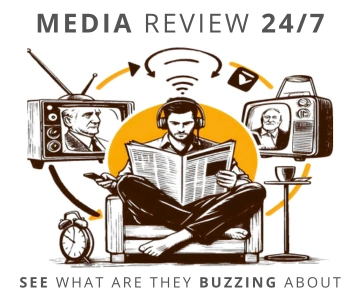By 1928, the United States had three national radio networks, two of which were managed by NBC (National Broadcasting Company), and one by CBS (Columbia Broadcasting System). Radio attracted listeners with excellent entertainment programs and live reports from the scene. These captured special attention during the Great Depression of the 1930s and World War II. President Franklin Roosevelt discovered and used the power of radio - his "fireside chats," in which he informed the nation about efforts to control economic problems or war progress, became a hallmark of American radio and established a new way for leaders to communicate with the public. After 1945, radio began to lose popularity as television entered the media scene.
Radio broadcasters had to adapt to the new situation - they quickly found a way to fill the gap left by the masses of listeners captivated by television. Since they couldn’t compete with TV in terms of visual effects and drama, they shifted to a music-news format. When car manufacturers began offering built-in radios as standard in the 1950s, the "elder sister" regained favor. After all, what could be more enjoyable than listening to news and favorite hits while stuck in traffic on the way to work?
Interestingly, radio didn’t change significantly in the first half-century of its existence. Traditional AM radio, with relatively poor sound quality but broader signal range, served Americans until the 1970s. Only then did music stations experience a true FM boom. Inventions like the "Walkman" popularized the new sound quality. This led to a split among broadcasters: FM dominated music stations, while those focusing on news (the so-called talk radio) remained on AM.
This format has enjoyed great popularity in the U.S. for 25 years - today, over 1,000 of the 10,000 commercial stations give listeners a chance to hear opinions from celebrity guests or experts and to call in and share their own views. In recent years, both AM and FM radio have gone through a transformation. To retain listeners, broadcasters often choose to specialize. Thus, in the U.S., we have the "big five hot topics":
- country music
- adult programming
- top 40
- religion
- oldies.
In a world dominated by media led by television, radio continues to fight for its audience - and achieves some success. In the U.S., 99% of households have at least one radio - on average, there are five radios per home! At any given moment, over 80% of Americans are listening to the radio! Over the past decade, radio revenue has increased from $8.4 billion to $17 billion!
The number of commercial stations across the U.S. has steadily grown. Currently, there are about 4,793 AM and 5,662 FM stations, though it’s hard to determine how many might appear or disappear in the coming weeks. In the public radio sector, turnover isn’t as noticeable. In recent years, the number of these stations has remained steady at 1,460. Most operate for educational purposes at universities or other institutions, funded by grants (public or private), subscriptions, or endorsements. Their activities are overseen by NPR (National Public Radio), a network that connects all non-commercial stations and ensures their access to information and priority in content creation. Public radio in the United States (including NPR and Public Radio International) reaches over 20 million Americans daily.
The magic of radio has enchanted people worldwide for years. Hundreds of programs have their loyal listeners who tune in daily, weekly, to listen to the "wooden box" (although today that term is quite outdated). Yet, something wields greater power over us - television.
Read all articles in the series The Fourth Estate in America.
COMMERCIAL BREAK
New articles in section History of the media
The History of The New York Times. All the news that's fit to print
Małgorzata Dwornik
In the heart of 19th-century New York, when news from across the world traveled via telegraph and the newspaper was the voice of public opinion, two ambitious journalists created a modest four-page daily that would eventually become a legend.
FORTUNE. The story of the most exclusive business magazine
Małgorzata Dwornik
Half of the pages in the pilot issue were left blank. Only one printing house in the country could meet the magazine’s quality standards. They coined the terms "business sociology" and "hedge fund". They created the world’s most prestigious company ranking. This is the story of Fortune.
History of Le Soir. A Belgian daily once free for ground floor readers
Małgorzata Dwornik
It started with an unusual sales policy and articles written personally by the king. This is where the comic hero Tintin made his name. The "fake edition" from the II World War went down in history. "Le Soir" more than once found itself targeted by authorities, censors, and even... terrorists and hackers.
See articles on a similar topic:
Yahoo! The history of the fallen giants of the internet
Małgorzata Dwornik
What began as an idea for a website directory to organize the chaos of the web became one of the first online market giants. Its story is one of a rapid rise and a painful collapse under its own weight. Though in September 2021, there was a glimmer of hope. Again.
History of De Standaard. A Flemish newspaper with a turbulent past
Małgorzata Dwornik
The first issue was supposed to reach readers on 1914. However, the outbreak of World War I disrupted these plans. It finally debuted after 4 years. It survived another war, a publication ban, bankruptcy, and the digital revolution. More than a century later, it remains strong.
It all began with a one-letter typo. The story of Oprah Winfrey
KFi
One misplaced letter on her birth certificate turned Orpah into Oprah, and one charismatic hour each afternoon turned a local talk show into a cultural super-power. Here’s the story of a girl in potato-sack pants claimed the throne of TV and talk-shows.
History of La Repubblica. How an Italian Newspaper Became a Fortress
Małgorzata Dwornik
When Eugenio Scalfari handed the first issue to readers in 1976, he dreamed that La Repubblica would become Italy’s second most-read newspaper - independent and fighting manipulation. He reached that goal in nine years. A year later, La Repubblica was the biggest paper in the country. Only the internet changed that.





























